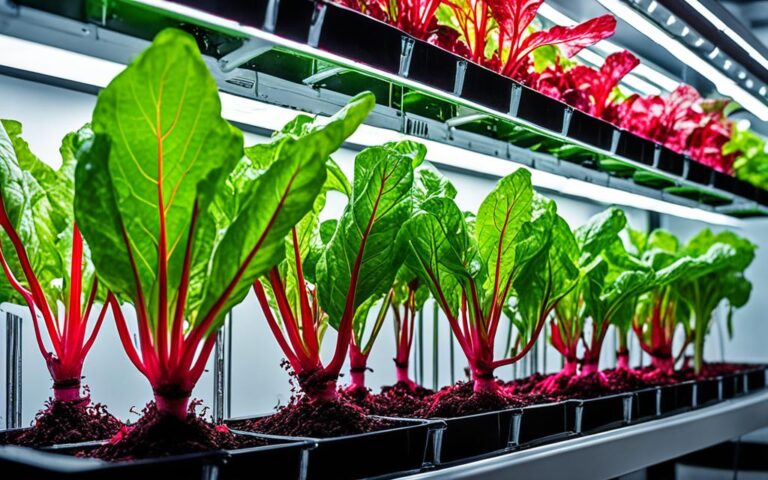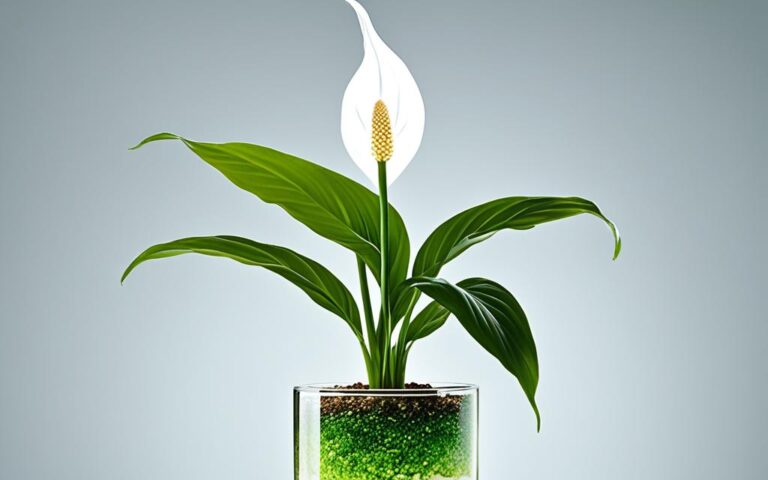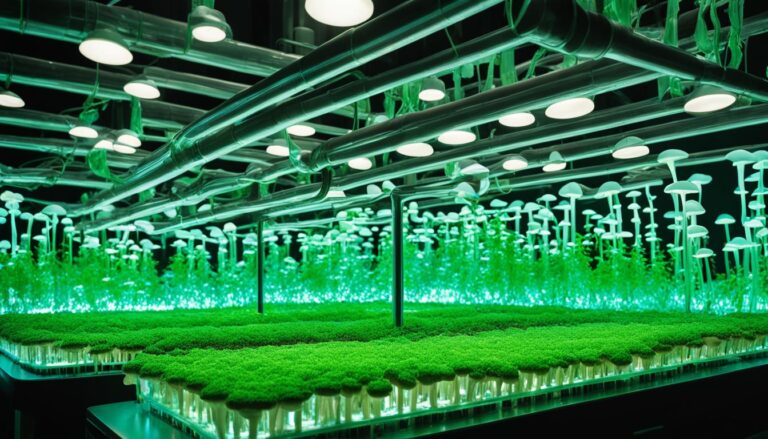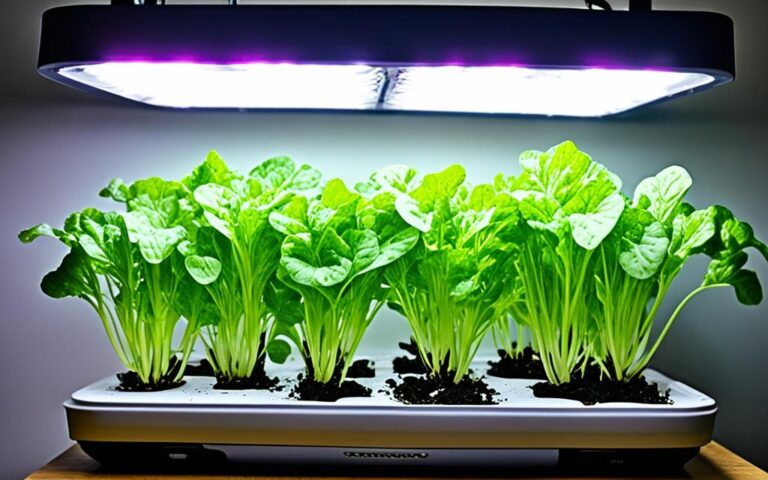Growing Hydroponic Grapes: Tips for Success
As the world fights against climate change, finding sustainable ways to produce our needs is key. Viticulture, or growing wine grapes, is a field ripe for a green makeover. Hydroponic vineyards are leading the charge with their soilless cultivation method. They grow plants in a nutrient-rich water solution instead of soil.
This method is better than traditional vineyards in many ways. It uses resources more efficiently, saves water, and grapes can be grown all year. It’s a win-win for the planet and grape growers.
Key Takeaways
- Hydroponic systems in wine grape cultivation can use up to 90% less water compared to traditional soil-based methods.
- Hydroponic vineyards enable more efficient nutrient uptake by plants, resulting in faster growth rates and higher yields.
- Hydroponics minimizes the environmental impact of grape cultivation by reducing resource wastage and optimizing efficiency.
- Hydroponic systems provide consistent grape quality, allowing for predictable flavor profiles in wines.
- Year-round grape cultivation is possible with the controlled environments of hydroponic vineyards.
Table of Contents
Introduction to Hydroponic Grape Growing
What is Hydroponic Growing?
Hydroponic growing is a way to grow plants without soil. It uses a special water solution full of nutrients to feed the plants. This method gives plants everything they need to grow well, like nutrients, water, and oxygen.
Hydroponic systems send a mix of minerals, vitamins, and water straight to the roots of the plants. This helps plants grow strong and healthy.
Benefits of Hydroponic Growing for Grapes
Using hydroponics for grape growing has many advantages. For one, it saves a lot of water, up to 90% less than traditional farming. This is great for areas where water is scarce.
Hydroponics also helps control pests and diseases better. This makes grape growing more sustainable and effective.
Another big plus is how it uses space. By growing grapes vertically, farmers can make the most of small areas. This is perfect for city farming or small vineyards.
Hydroponics also lets grapes grow all year round. This means growers can have a steady supply of fresh grapes, no matter the weather outside.
Finally, hydroponic grape growing means you can control exactly what nutrients the grapes get. This leads to better grape quality, consistency, and yield. It’s a great choice for wine grape producers and fans.
| Key Benefit | Description |
|---|---|
| Water Conservation | Hydroponic systems can use up to 90% less water compared to traditional soil-based farming. |
| Pest and Disease Control | The controlled environment of a hydroponic setup helps minimize the risk of pests and diseases. |
| Space Utilization | Vertical cultivation in hydroponic systems allows for efficient use of limited spaces, making it ideal for urban farming or small-scale vineyards. |
| Year-round Cultivation | Hydroponic systems enable continuous grape production, regardless of external weather conditions. |
| Precise Nutrient Delivery | Hydroponic growing provides the ability to precisely control the nutrient solution, ensuring optimal grape quality, uniformity, and yield. |
Hydroponic Systems for Grape Cultivation
Growing grapes with hydroponics has many benefits. It gives growers more control over the environment and helps reduce pest problems. There are different hydroponic methods for growing grapes, each with its own advantages.
Nutrient Film Technique (NFT)
In an NFT system, grapevine roots hang in a flow of nutrient-rich water. This setup keeps the plants well-fed and watered. It also makes sure the roots get enough oxygen.
Deep Water Culture (DWC)
The DWC system dips grapevine roots in a tank of nutrient solution. This method gives the roots steady access to water and nutrients. It helps the plants grow strong and produce a lot of grapes.
Aeroponics
Aeroponics suspends grapevine roots in the air and sprays them with a nutrient mist. This method lets growers control exactly how much nutrients the plants get. It helps the plants grow better and faster.
Each hydroponic method for grapes has its own benefits. The nutrient film technique is great for efficient water and nutrient use. Deep water culture is good for steady water supply. Aeroponics is all about precise nutrient application. By picking the right hydroponic system, grape growers can improve their farming and get more grapes.
“Hydroponic grape growing can save up to 90% of water consumption compared to traditional soil-based farming.”
Hydroponic farming creates a controlled environment. This protects investments from damage by vandals. The farm’s size determines the hydroponic system’s size; big farms need complex setups. When choosing a hydroponic system, consider your budget and what you need for your crops and irrigation.
Essential Nutrients for Hydroponic Grapes
For hydroponic grape success, the right nutrients are key. Growers must balance the nutrient solution carefully. This ensures grapes get the right mix of nutrients like nitrogen, phosphorus, potassium, calcium, and magnesium. Keeping an eye on the pH and electrical conductivity (EC) levels is also vital. These levels affect how well the plants absorb essential nutrients for hydroponic grapes.
Nutrient Solution Management
German botanists Julius Von Sachs and Wilhelm Knop created the first nutrient formula for hydroponics in 1860-61. William Frederick Gericke made hydroponics popular in the 1930s with his experiments. Today, growers must tweak the nutrient solution management for the best growth of hydroponic grapes.
pH and EC Requirements
The pH and electrical conductivity (EC) of the nutrient solution matter a lot for grapevines. They do well in a slightly acidic environment, with a pH of 5.5 to 6.5. The EC, which shows the salt level, should be between 1.5 and 2.5 mS/cm (millisiemens per centimeter) for hydroponic grapes. Keeping a close watch on these pH and EC requirements helps the plants absorb nutrients well. This leads to better growth, yield, and grape quality.
| Parameter | Optimal Range for Hydroponic Grapes |
|---|---|
| pH | 5.5 – 6.5 |
| EC (Electrical Conductivity) | 1.5 – 2.5 mS/cm |
“Closely monitoring and adjusting the pH and EC levels is essential for ensuring optimal nutrient absorption and overall plant health in hydroponic grape cultivation.”
Selecting the Right Hydroponic Grape Varieties
Choosing the right grape varieties for hydroponics is key to success. Many grapes grow well without soil, but some do better than others. This depends on the climate, growing conditions, and how you plan to use the grapes.
Concord, Niagara, and seedless table grapes are popular for hydroponics. These grapes do well in controlled systems, making great fruit for eating fresh, making wine, or grape jelly.
For wine, red and white grapes like Aligot, Chardonnay, Pinot Noir, and Cabernet Sauvignon are top choices. Seedless grapes are best for eating fresh. St. Pepin and Valiant grapes are great for grape jelly and preserves.
When picking hydroponic grape varieties, think about what you want to do with the grapes. Consider how they handle the climate, fight diseases, and grow well without soil. Choosing the right varieties can help growers succeed and get top-quality grapes.

“Grapes have numerous health benefits, such as decreasing the incidence of heart disease and inhibiting cancer, due to their high concentration of compounds like resveratrol.”
By picking the right best hydroponic grape varieties for your conditions and goals, growers can make the most of this rewarding crop.
Starting with Seeds or Transplants
Growing hydroponic grapes can start with seeds or transplants. Each method has its own benefits. The choice depends on what the grower wants, their resources, and what they like.
Advantages of Starting from Seeds
Using hydroponic grape seeds gives you control over the plant’s genetics. This is great if you want a specific grape type or to try new ones. It’s also cheaper than buying hydroponic grape transplants at the start.
But, starting with hydroponic grape seeds takes time. It can be several months before the plants are ready for the hydroponic setup. You’ll need to plan for this extra time and effort.
Advantages of Using Transplants
Choosing hydroponic grape transplants gives your plants a head start. They’re more developed and adjust to hydroponics faster than seeds. This means a quicker harvest and a sooner return on your investment.
But, hydroponic grape transplants can be tricky to move to hydroponics. They might be more expensive than hydroponic grape seeds at the start.
So, whether to use hydroponic grape seeds or hydroponic grape transplants depends on your needs and goals. Both ways can lead to a great hydroponic grape harvest with the right care.
Setting Up Your Hydroponic Grape System
Starting a hydroponic grape system needs a lot of thought. You must pick the right hydroponic system, like a Nutrient Film Technique (NFT) or Deep Water Culture (DWC). Make sure it fits the needs of grapevines.
Hydroponic grape towers are great for saving space, letting grapes grow up. Or, you can use hydroponic tables for growing table grapes.
Choosing a system means you need to support the vines well. You also need to give them the right nutrients and keep the environment perfect for growth. This might mean adding things like:
- A strong trellis or support system for the vines
- A good way to deliver nutrients, like drip irrigation or a recirculating system
- Control over temperature, humidity, and light to match the best growing conditions
Hydroponic grape farming is a long-term job. Grapevines live for years and need careful planning and work to thrive. Make sure you plan well for your best hydroponic system for grapes.
| Hydroponic System | Key Features | Suitability for Grapes |
|---|---|---|
| Nutrient Film Technique (NFT) | Continuously recirculating nutrient solution, shallow growing channels | Good for compact grape types, needs careful management |
| Deep Water Culture (DWC) | Roots in oxygenated nutrient solution, no soil | Great for big grape varieties, gives roots lots of room |
| Vertical Hydroponic Grape Tower | Stacked growing levels, uses space well | Perfect for hydroponic grape towers, makes the most of small space |
Picking the right hydroponic system and making the best growing space helps growers get the most from hydroponic grape farming. This way, they can grow healthy, tasty grapes all year.

Light and Temperature Requirements
Growing hydroponic grapes needs careful control of light and temperature for best growth and grape production. Grapevines do well in full sun, needing 6 to 8 hours of direct sunlight daily. If sunlight is scarce, like in indoor setups, adding LED or HID grow lights can help meet the hydroponic grape light requirements.
Types of Grow Lights
The right grow lights for hydroponic grapes depend on energy use, light spectrum, and heat. Let’s explore some common grow light types:
- LED Grow Lights: These lights are energy-saving and give a wide spectrum, including photosynthesis-friendly wavelengths. They also produce little heat, perfect for indoor setups.
- HID (High-Intensity Discharge) Grow Lights: HID lights, like HPS or MH lamps, give strong light and are often used in big setups. But, they can get hot, so temperature control is key.
- Fluorescent Grow Lights: Fluorescent lights are budget-friendly and offer a balanced spectrum. They work well in smaller setups but might not match LEDs or HID in efficiency.
The ideal temperature range for growing hydroponic grapes is 72-82°F (22-28°C). Keeping this temperature is vital for healthy vines, fruit growth, and top-quality grapes.
Choosing the right types of grow lights for hydroponic grapes and the perfect temperature helps create a great environment for growing grapes.
Hydroponic Grapes: Maximizing Yield and Quality
Hydroponic grape growers aim for the best yields and grape quality. They use smart techniques to make their grapes look great and taste better. This makes their grapes stand out.
Enhancing Color and Uniformity
Growers boost grape color and size by managing canopies and thinning clusters. They also use plant growth regulators. These steps make sure each grape gets enough water, sunlight, and nutrients. This leads to grapes that are the same size, color, and sweet.
Keeping grapevines healthy is key for great grapes. Growers give vines the right nutrients and control the environment. This helps grapes grow into tasty, quality grapes.
Combating Powdery Mildew
Powdery mildew is a big problem for hydroponic grapes. It loves warm, humid places and can hit vines, leaves, and grapes. To fight it, growers keep vines healthy with good nutrients and water.
Using NanoCrop fungicide helps too. It protects against mildew without harming the grapes or the environment. This keeps grapevines strong and productive.
| Key Factors for Enhancing Hydroponic Grape Yield and Quality | Description |
|---|---|
| Canopy Management | Proper pruning and training to optimize sunlight exposure and air circulation |
| Cluster Thinning | Removing excess grape clusters to ensure adequate nutrient and water distribution |
| Plant Growth Regulators | Selective use of hormones to enhance color, uniformity, and Brix levels |
| Nutrient Management | Providing the optimal balance of essential macro- and micronutrients |
| Powdery Mildew Control | Implementing organic fungicide solutions, such as NanoCrop, to prevent disease outbreaks |
By using these methods, hydroponic grape growers can get more and better grapes. They produce grapes that are colorful, tasty, and resistant to disease. This meets what the market wants.

Pest and Disease Management
Keeping a hydroponic grape vineyard healthy means watching out for pests and diseases. Hydroponic systems are less likely to get pests from the soil. But, they can still face issues with insects like spider mites, especially in hot, dry places. To fight these pests, growers can use natural predators, such as minute pirate bugs, by planting diverse crops and keeping the vineyard balanced. Using organic and biological controls, like predatory mites, can also help manage pests without harmful chemicals.
Common Pests in Hydroponic Vineyards
Hydroponic grape growers need to know about pests that can harm their crops. Some common pests include:
- Spider mites: These tiny pests can suck sap from grape leaves and clusters, causing damage.
- Mealybugs: These bugs can cover grape clusters, affecting fruit growth and development. Bad infestations can kill young vines.
- Grape leaf folder: The larvae of this pest eat the top of grape leaves, damaging the vines.
- Beetles: Beetles can harm buds, leading to fewer grapes and lower yields.
- Thrips: These small insects can harm blossoms and new berries, reducing fruit setting and yield.
To fight these pests, growers can use organic pest control methods and attract beneficial insects that eat these pests.
| Pest | Impact on Hydroponic Grapes | Organic Control Methods | Beneficial Insects |
|---|---|---|---|
| Spider mites | Cause damage to leaves and clusters | Introduce predatory mites, use diatomaceous earth | Minute pirate bugs |
| Mealybugs | Cover fruit, affect set and development, can kill young vines | Use insecticidal soaps, apply Bacillus thuringiensis | Ladybird beetles, lacewings |
| Grape leaf folder | Skeletonize leaves, cause visible damage | Remove affected leaves, use pheromone traps | Parasitic wasps |
| Beetles | Damage buds, lead to lower yields | Use row covers, apply neem oil | Ground beetles, rove beetles |
| Thrips | Attack blossoms and berries, reduce fruit set and yield | Introduce predatory mites, use insecticidal soaps | Minute pirate bugs, lacewings |
Using a mix of integrated pest management (IPM) strategies can help hydroponic grape growers keep pests under control. This approach combines organic and biological controls for a healthy, productive vineyard.
Pruning and Training Techniques
Proper pruning and training are key for growing hydroponic grapes. These vines need special care to grow well. They need the right support, enough light, and balanced fruit production.
Growers use grapevine training systems for hydroponic setups like trellises or vertical shoots. These methods help vines grow well and produce more. Hydroponic grape pruning is also important. It keeps vines in shape, improves air flow, and makes grapes better by controlling growth and fruit amount.
Trellis Systems for Hydroponic Grape Training
Trellises are a top choice for hydroponic grape training. They support vines and let air and light in. Popular trellis types include:
- Gable trellis
- Two-wire vertical trellis
- Overhead trellis
- Bilateral cordon trellis
The right trellis depends on the grape type, how much you want to grow, and your space.
Pruning Techniques for Hydroponic Grape Production
Pruning is vital for hydroponic grape pruning. Growers use spur, cane, and renewal pruning. These methods keep vines healthy, control growth, and boost grape quality. Pruning also helps manage fruit amount, air flow, and fights diseases.
| Pruning Technique | Description |
|---|---|
| Spur Pruning | Cutting back the previous year’s growth to 1-2 buds, promoting the development of new fruiting canes. |
| Cane Pruning | Selecting and retaining specific canes from the previous season’s growth, which will bear the current year’s crop. |
| Renewal Pruning | Removing older wood to encourage the growth of new, more productive canes and spurs. |
Using these hydroponic grape training and pruning methods helps growers get the most from their vines. This leads to a great harvest full of quality grapes.
Water and Nutrient Monitoring
For hydroponic grape success, it’s key to keep water and nutrients in check. Growers must watch the nutrient solution’s makeup, like hydroponic grape nutrient management, pH, and EC. This ensures vines get the right mix of nutrients.
Testing the hydroponic grape nutrient solution often is a must. It lets growers tweak the solution to avoid nutrient shortfalls. They should also focus on hydroponic grape water management. This includes recycling water to save resources and keep vines thriving.
| Nutrient | Optimal Range (mg/L) |
|---|---|
| Nitrogen (N) | 168 – 236 |
| Phosphorus (P) | 31 – 60 |
| Potassium (K) | 156 – 300 |
| Calcium (Ca) | 160 – 185 |
| Magnesium (Mg) | 34 – 50 |
| Sulfur (S) | 48 – 68 |
| Iron (Fe) | 2.5 – 12 |
| Copper (Cu) | 0.02 – 0.1 |
| Zinc (Zn) | 0.05 – 0.1 |
| Manganese (Mn) | 0.5 – 2 |
| Boron (B) | 0.3 – 0.5 |
By keeping a close eye on and adjusting the nutrient solution, growers can make sure their hydroponic grape vines get the nutrients they need. This leads to healthy growth, strong vines, and better grapes. Regular testing and active nutrient management are key to a successful hydroponic grape farm.
Harvesting and Post-Harvest Handling
Getting hydroponic grapes ready for market takes careful steps from harvest to storage. It’s key to pick the grapes at the right time for the best taste and quality. Growers watch the grapes closely to know when they’re ripe.
After picking, keeping the grapes in top shape is crucial. This means handling them gently, controlling the temperature, and storing them right. These steps help keep the grapes fresh, whether they’re sold right away, made into products, or sent further.
Hydroponic Grape Harvesting
Picking the grapes at the best time is vital for top-notch hydroponic grape harvesting. Growers check the grapes’ sugar levels, acidity, and color to pick the perfect moment. The grape type, growing conditions, and its final use affect when to harvest.
Post-Harvest Handling Practices
After picking, taking good care of the grapes is key to keeping them fresh and long-lasting. This includes:
- Gentle handling to avoid damage
- Quick cooling to 32-34°F (0-1°C)
- High humidity, 90-95%, to keep moisture in
- Sorting to remove bad grapes
- Using clean containers
Storage and Transportation of Hydroponic Grapes
After initial handling, grapes need the right storage and transport to stay fresh. This means:
- Keeping them in temperature-controlled places, like cold rooms or refrigerated trucks
- Watching and adjusting humidity to prevent drying out or mold
- Ensuring good air flow and not stacking grapes too high
- Using special packaging for transport
By following the best steps from harvest to transport, growers can make sure their grapes are of high quality. This ensures a great product gets to consumers.
| Recommended Storage Conditions for Common Hydroponic Crops | Temperature (°F) | Humidity (%) | Storage Duration |
|---|---|---|---|
| Beets | 32 | 90-100 | 3-5 months |
| Carrots | 32 | 90-100 | up to 6 months |
| Kohlrabi | 32 | 90-100 | up to 4 months |
| Parsnips | 32 | 95 | up to 5 months |
| Potatoes | 40 | 95 | up to 5 months |
| Rutabaga | 32 | 90-100 | 4-6 months |
| Sweet Potatoes | 60 | 85 | up to 7 months |
| Turnips | 32 | 90-100 | 4-5 months |
Challenges of Growing Hydroponic Grapes
Hydroponic grape growing has many benefits, but it also has challenges. One big issue is using space well, especially in crowded cities or areas with little land. But, hydroponics can solve this with new ways to farm vertically, like using grape towers. These methods make the most of small spaces.
Space Utilization and Urban Farming
More people want hydroponic produce now, thanks to a soil ban on some chemicals. This has made growing grapes without soil a good choice for city farmers and those with little land. It lets them enjoy the benefits of growing grapes without soil.
Flex Farms is a top company in urban farming that shows how well hydroponic grapes can do in small spaces. In 2022, they made 4.1 million servings of food, saved 2.7 million food miles, and cut down on 337,814 pounds of food waste. They also saved 19 million gallons of water. Their systems can grow 25 pounds of lettuce every 28 days in just nine square feet, showing how space-saving hydroponics can be.
Hydroponics can produce 45 times more food than traditional farming, using much less water and land. This makes it a great choice for city farmers who want to grow more food and help the environment.
“Hydroponic wine grape cultivation offers increased yields, often surpassing those from traditional vineyards, and a reduction in pesticide usage compared to conventional methods.”
Even with challenges, hydroponic grape growing is a strong option for city farmers with little space. By using vertical farming and making the most of what they have, they can beat the space problem and succeed in urban farming.
Conclusion
Hydroponic grape growing is a new way to farm grapes that is good for the planet and innovative. It lets grape growers control the growing conditions better. This means they can give grapes exactly what they need, use water wisely, and keep pests away. This leads to more grapes and better quality grapes.
As we face climate change and less resources, hydroponic grape farming is becoming key for a sustainable future. It helps grape growers keep their vineyards healthy and green. And it makes sure consumers get top-notch grapes.
Recently, hydroponic tech has become more popular in the wine world. It’s because it makes grapes better and is good for the earth. Hydroponics can use less water, take up less space, and avoid diseases that come from soil. This makes it a big hope for the wine industry’s future, helping meet the demand for sustainable and quality grapes.






